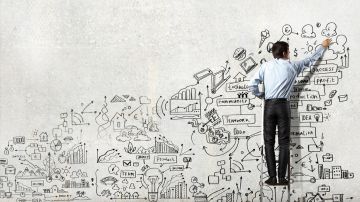If you had to name the greatest entrepreneur in the history of mankind, who would you chose? the man who created the iPhone, the ‘difficult’ pupil who went on to invent the electric light bulb or the woman who believed every woman could be beautiful. It’s an easy question but it’s not an easy one to answer, as INCH discovered.
APPLE
Steve Jobs (1955 – 2011) was the co-founder of Apple. He and school friend Steve Wozniak sold their first Apple computer in 1976. He later left Apple amid disputes in 1985 but returned in 1996 and became its CEO in 1997. He went on to tackle Apple’s poor profitability and oversaw the development of the iPod, the iPhone and iPad. His greatest gift, said many, was his ability to second guess the market and design an innovative product that everyone wanted.
AMAZON
Jeff Bezos (1964 -) left a well-paid job with a New York City hedge fund to set up e-commerce site Amazon in his garage in 1994. Initially the site sold only books but he wasn’t content with being a bookseller. He wanted more for Amazon. He went on to make online shopping so easy that today customers can find and buy almost everything they want at the touch of a button. It is now the largest retailer on the Internet.
FACEBOOK
Mark Zuckerberg (1984 –) started writing computer programmes at school. Several companies – including AOL and Microsoft – expressed an interest in hiring him before he graduated from Harvard University. He turned them down and went on to create Facebook. Today his social networking site has more than one billion users and market capitalisation of more than $150 billion.
STEEL INDUSTRY
Andrew Carnegie (1835 – 1919) is best known for his gifts of free public library buildings but he was also an industrialist who led the enormous expansion of the American steel industry in the late 19th century. When he sold his company to JP Morgan in 1901, it was valued at more than $400 million. He was driven by a desire to help others. When he died in 1919, he had given away about $350 million of his fortune. He once wrote: ‘The who dies thus rich, dies disgraced.’
AIRCRAFT
The first airplane was invented by Wilbur Wright (1867 – 1912) and his brother Orville (1871 – 1948). After spending a great deal of time watching birds in flight, they finally showed the world that man could fly when they flew their plane for 12 seconds for a distance of 120 feet on December 17, 1903, astounding everyone.
IKEA
Swedish-born Ingvar Kamprad (1926 -) started selling matches, which he bought in bulk from Stockholm, to his neighbours when he was 14. Amazed that he could buy a product and resell it for a profit fuelled his ambitions. He went on to sell fish, Christmas decorations, pens, pencils and seeds. At 17 he named his new venture IKEA and added further goods. By 21 he was also selling furniture and by 27 – in 1953 – he opened his first IKEA showroom. Today IKEA has stores in 25 countries with annual sales of more than 21 billion Euros.
THE CAR
Henry Ford (1863-1947) brought the car to the masses. His Model T was everything he thought a car should be – reasonably priced and reliable – but only a few could be made in a day which wasn’t enough to satisfy demand. In the end he opened a large factory with an assembly line and went on to become the biggest car manufacturer in the world with a car that was simple to drive and cheap to repair.
COSMETICS
Estée Lauder (1906 – 2004) was the daughter of a Hungarian immigrant. She founded her cosmetics company in 1946 armed with just four products and an unshakeable belief: that every woman can be beautiful. She began by selling skin care products to beauty salons and hotels, and believed that to make a sale, you needed to touch the customer. ‘I didn’t get there by wishing for it or hoping for it, but by working for it,’ she often reminded her sales team. Today her cosmetics are one of the leading brands in the world.
JEANS
Levi Strauss (1829–1902) was born in Germany, but moved America in 1847 to work for his brothers. Six years later he started his own company, importing clothing, underwear, umbrellas and fabric which he sold to small stores all over the west coast of America. But it was customer, a tailor, who gave Levi the idea of making heavy-duty ‘waist overalls’, which we now know as jeans. Initially it is believed the jeans were made by individual seamstresses but by the 1880s, as jeans grew in popularity, he opened his own factory. The rest is history.
THE PRINTING PRESS
Johannes Gutenberg (1395 – 1468), a German goldsmith and businessman, invented a printing press with replaceable/ moveable wooden or metal letters in 1436. His invention, for which he needed to borrow money, is credited for revolutionising the production of books.
THE COMPASS
The Chinese invented the first compass during the Han Dynasty. It was made of lodestone, a naturally magnetized iron ore. The compass enabled mariners to navigate safely far from land, increasing sea trade and contributing to the Age of Discovery.
EXPLORER
Portuguese Ferdinand Magellan (1480 – 1521) organised the expedition that resulted in the first circumnavigation of the Earth. He assembled a fleet of five ships and despite huge setbacks, including the master of one of the ships sailing back home and Magellan’s own death (he was killed during the Battle of Mactan), he proved the world was round.
THE LIGHT BULB
Thomas Edison (1847 – 1931) was the youngest of seven children. His mother decided to teach him at home after his teacher described him as difficult. He didn’t learn to talk until he was four after which he never stopped asking ‘why?’ At 12 he started selling newspapers and later published his own small newspaper. During his lifetime he filed more than 1,000 patents, including the electric light bulb, the first practical dictaphone, the phonograph and the storage battery. He obtained his last patent at 83. To many he will always be the greatest inventor who ever lived.
GOOGLE
Larry Page (1973 -) and Sergey Brin (1973 -) met at Stanford University in 1995. Larry was considering the school; Sergey was assigned to show him around. Two years later the two students co-founded Google, which went on to become one of the fastest growing businesses of all time. Today Google is the most popular search engine. Their philosophy is simple: Great just isn’t good enough.
ANIMATED FILMS
Walt Disney, creator of such magical figures as Mickey Mouse and Snow White, pioneered the fields of animation. During his 43-year career in Hollywood, he became known for taking the dreams of America and making them come true. His drive to perfect the art of animation was endless. When Technicolor was introduced to animation, he held the patent for two years, which meant he was the only person to make colour cartoons.
THE INTERNET
Computer scientist Sir Timothy Berners-Lee (1955 -) invented the World Wide Web, an internet-based hypermedia initiative for global information sharing while at CERN, the European Particle Physics Laboratory, in 1989. The proposal was meant for a more effective CERN communication system but he realised the concept could be implemented throughout the world. The first website was built at CERN and finally went online on August 6, 1991.
TATA GROUP
J R D Tata (1904 – 1993) became India’s first licensed pilot in 1929 and went on to found India’s first commercial airline, Tata Airlines, in 1932, which later became Air India. He joined his uncle’s company, Tata & Sons, as an unpaid apprentice in 1925. In 1938 – at the age of 34 – he was elected chairman. Under his chairmanship the group’s assets grew from $100 million US dollars to $5 billion US dollars. He started with 14 enterprises and, when he retired, there were 95 enterprises in the Tata Group.
CHINA YOUTHOLOGY
Zafka Zhang co-founded market research company China Youthology in 2008. He believes today’s generation in China has the power to change society. Companies such as Audi, Nokia, L’Oreal, and Daimler have all used his online business to tap into China’s youth culture and understand how to market their own brands better.
MICROSOFT
Bill Gates (1955 -) began programming computers at 13. He dropped out of Harvard to devote his energy to Microsoft, driven by the belief that the computer would be a valuable tool on every office desktop and in every home. He began developing software for personal computers and led the personal computer revolution. Having already given away $28bn to his Foundation, Bill Gates now intends to eradicate polio, with the same drive he brought to Microsoft.
MOBILE PHONE
Martin Cooper (1928 -) came up with the concept of the hand-held mobile phone while working at Motorola in 1973. The prototype, which weighed two kilos, is believed to have cost Motorola about $1 million in today’s money. The battery last 20 minutes but it didn’t matter because you couldn’t hold the phone for that long.
THE TELEPHONE
Alexander Graham Bell (1847 – 1922) was the first to be awarded a patent for the electric telephone in 1876. He improved on the design and by 1886 more than 150,000 people owned telephones in the United States. He later said: ‘The day will come when the man at the telephone will be able to see the distant person to whom he is speaking.’
FEDEX
Fred Smith (1944 -) took money left to him by his late father and founded Federal Express, a global overnight delivery service that a professor had warned him was unworkable. His company, now known as FedEx, is now believed to be the largest transportation business in the world, processing more than eight billion pieces of freight every day, and operating in at least 220 countries.
PAPAYAMOBILE
Si Shen was inspired after reading The Road Ahead by Microsoft founder Bill Gates. He wanted to change the world; so did she. After working for Google for several years, she left and returned to Beijing where she and a friend launched Papaya in 2008. Today she turns mobile phones into social networks. The software lets people share pictures, send messages and play games with others and it is believed to have more than 35 million users.
VIRGIN GROUP
Sir Richard Branson (1950 -) dropped out of school at 16 and started out by selling records to his friends at the lowest price possible in 1970. He later opened a record shop in Oxford Street, London, and built a recording studio, signing artists such as The Rolling Stones. Today Virgin Group, which he founded, comprises of more than 400 companies.
STARBUCKS
It all started with a cup of coffee. Howard Schultz (1953 -) was so inspired after speaking to the staff at Starbucks in Seattle in 1981 that he joined the company as director of marketing the following year. At the time Starbucks had only four stores. In 1983, during a trip to Italy, he had a vision to bring the Italian coffeehouse tradition to America. He left Starbucks for a while, hoping to strike out on his own, but returned in 1987 and bought the company. Today Starbucks has more than 17,000 stores in 60 countries.


















